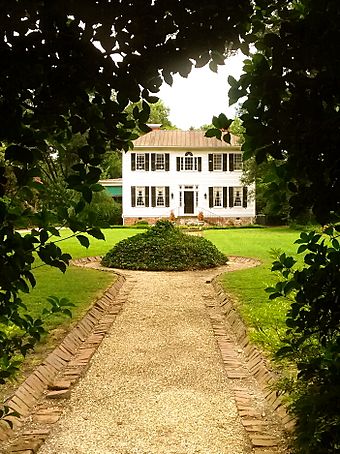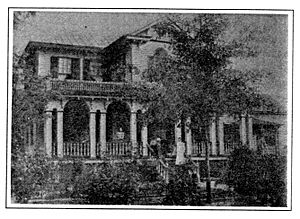Earle Town House facts for kids
Quick facts for kids |
|
|
Earle Town House
|
|

Earle Town House, August 2014
|
|
| Location | 107 James Street, Greenville, South Carolina |
|---|---|
| Area | less than one acre |
| Built | c. 1829-34 |
| Architectural style | Georgian |
| NRHP reference No. | 69000167 |
| Added to NRHP | August 5, 1969 |
The Earle Town House is a very old and important house located in Greenville, South Carolina. It was added to the National Register of Historic Places on August 5, 1969. This means it's officially recognized as a special historical building. It's also part of the Col. Elias Earle Historic District, which is a neighborhood with many historic homes.
For a long time, people thought this house was built around 1810 for a famous person named Elias T. Earle, who was a Congressman. However, it turns out he never actually owned the land! It's more likely that the house was built a bit later, between 1829 and 1833, by someone named Samuel Green. It might even have been built as late as 1834, after Elias Drayton Earle bought the land. Elias Drayton Earle was related to Elias T. Earle.
Who Lived in the Earle Town House?
The David Family's Time
In 1856, a man named James A. David bought the house along with a large piece of land, about 35 acres. His son, Charles A. David (who lived from 1853 to 1934), grew up and lived in the house until 1922. Charles was a merchant, which means he bought and sold goods. But he also loved to write funny stories, essays, and draw cartoons!
Charles David once described the house as a "rambling old affair." He said its wooden frame was put together with special joints called "mortised" and held with wooden pegs, like giant Lincoln Logs! He also joked that the ceilings were so high, the only way to heat the house in winter would be to "set it on fire." This gives us a funny picture of how big and drafty old houses could be.
Mary Simms Oliphant's Renovation
In December 1927, a very interesting woman named Mary Simms Oliphant bought the house. She was the granddaughter of a famous writer from the 1800s, William Gilmore Simms. Mary Oliphant was also a writer herself. She wrote more than a dozen books, including a history of South Carolina that was used in many schools.
In the 1920s, Mary Oliphant hired an architect named William Riddle Ward to fix up the house. She wanted to make it look like its original "Federal style," which was a popular building style in early America. To do this, they removed one part of the house and took away a porch with columns. They also added three new rooms to the second floor.
Even with these changes, some of the house's original features were kept. These included hand-cut wooden beams, brick and rock supports, special six-paneled doors, a beautiful hand-carved fireplace mantel, and a unique "Palladian window" on the second floor. A Palladian window is a large window with three parts: a tall arched window in the middle and two smaller rectangular windows on the sides.
Mary Oliphant worked hard to get her house and another nearby house called Whitehall listed on the National Register of Historic Places. They were the very first buildings in Greenville to get this special recognition! She also led a successful effort to stop local officials from building a new highway bypass through James Street, which would have affected her historic neighborhood.




